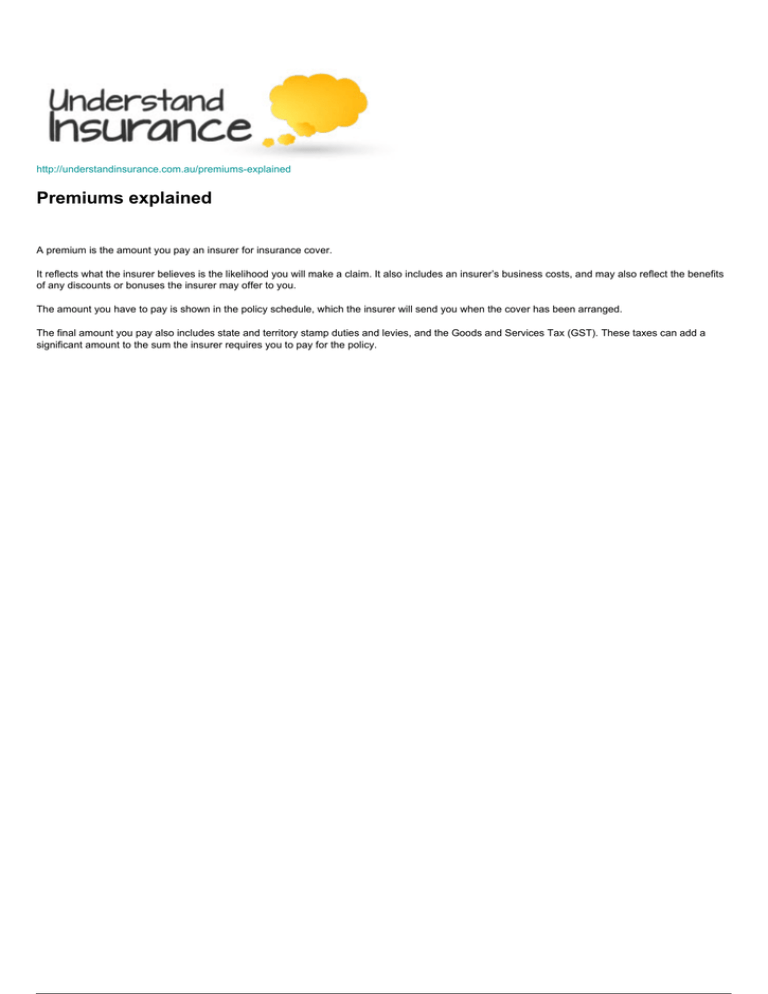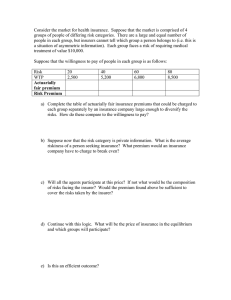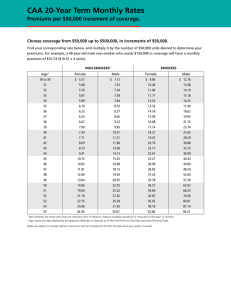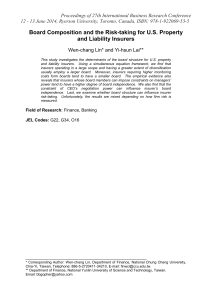Premiums explained - Understand Insurance
advertisement

http://understandinsurance.com.au/premiums-explained Premiums explained A premium is the amount you pay an insurer for insurance cover. It reflects what the insurer believes is the likelihood you will make a claim. It also includes an insurer’s business costs, and may also reflect the benefits of any discounts or bonuses the insurer may offer to you. The amount you have to pay is shown in the policy schedule, which the insurer will send you when the cover has been arranged. The final amount you pay also includes state and territory stamp duties and levies, and the Goods and Services Tax (GST). These taxes can add a significant amount to the sum the insurer requires you to pay for the policy. How it works – calculating premiums Insurers each make their own commercial decisions when deciding how much to charge each person who wants to cover certain risks for something valuable to them. For example, when you apply to insure your car for a comprehensive or a third party property policy the insurer will decide how much that particular car is worth (market value) and what risks are worth insuring. The insurer may also allow you to nominate the insured value of the vehicle. Insurers refer to data when they make these decisions. If the car is kept in a suburb with higher rates of car theft, you will be given a higher level of risk (and therefore may pay a higher premium) than someone whose car is kept in a place where car theft rates are low. Insurers may also look at other issues such as the driver’s age, their sex and claims history. This is because some demographics are statistically more likely to make a claim on their policy than others. Yet another factor that influences risk is the driver’s personal driving record. Most insurers will take into account whether you have been at fault in other accidents or whether you have been penalised for speeding, drink driving, or other traffic offences. All of these factors will help insurers work out an appropriate premium. Insurers must also decide how much coverage will be offered (unless you nominate a value) and in some circumstances may not offer insurance if the insurer believes the risk is too high. However, you must agree to all the terms of the policy when seeking the insurance cover, including the extent of cover and any terms and conditions, or the insurer will not offer it. You may also have a choice about some aspects of the policy, such as the amount of excess and optional extras. Similar principles are used in calculating premiums for all types of insurance. Why premium prices change Your premium is likely to change each time you renew your insurance, even if your personal circumstances don’t appear to have changed. This is because premiums are affected by many factors, including the cost of doing business and changes to the way your risk has been assessed. Sometimes premium prices will go up across the board, and sometimes your own premium might go up because your level of risk has increased. But if something helps to reduce the risk, this may be taken into account with a lower premium. There are a few different reasons your premium may change, including: Inflation. Insurers will often adjust premiums to keep pace with inflation Changes in government taxes and any state or territory duties or levies A reassessment of your individual risk by your insurer, especially following a claim or a natural disaster, or fresh information from government or an expert Changes you make that reduce your risk, such as installing a home alarm system The number of claims experienced in that sector of the insurance industry Large-scale claims due to natural disasters such as floods and cyclones Investment returns. Insurers invest premiums to help ensure they have sufficient capital to pay future claims. Poor returns may require a lift in premiums Regional or global changes that affect the price and availability of reinsurance The value or quantity of what you are insuring may have changed The insurer’s cost of doing business If there has been an unusually high number of claims in the previous year (for example, following a big natural disaster such as a cyclone, flood or bushfire), some insurers may need to increase premiums to restore the balance between the pool of funds available to pay claims and the risk. Your own premium might also go up (or down) because of a change in your risk. For example, if you received a speeding ticket or caused an accident, your insurance premium may go up at the time of renewing your policy (you are obliged to inform your insurer of these matters – see duty of disclosure [ http://understandinsurance.com.au/regulations-and-obligations#anchor-1 ] ). Receiving a renewal notice of a higher premium might prompt you to go searching for alternative policies which might offer cheaper premiums. Click here [ http://understandinsurance.com.au/review-and-renew ] for more information about renewing your insurance. It is important to shop around [ http://understandinsurance.com.au/buying-insurance#tab-1 ] to get the best policy for you, particularly if your own circumstances have changed over the year. It is also worth considering whether there have been any changes in your circumstances which might let your current insurer charge you a lower premium. For instance, if you have fitted a car alarm to your car, it is worth checking whether your current insurer offers a premium discount. You can also ask you insurer about what you can do to lower your premium. What may influence your premium? When your insurer calculates your premium, it is likely to take a range of factors into account. These factors will change from person to person. Some key factors influencing your premiums may include: Type of cover selected Any optional benefits you have selected under your policy Discounts you are eligible for Previous claims and incident history Whether you choose to pay your premium annually, monthly or by instalments Government taxes and any state or territory duties or levies How much cover you want Your risk assessment by the insurer The level of excess you select Balancing premium prices Working out the correct price for insurance premiums is a complex process that must balance the availability of funds, the likelihood of certain claims (the risk) and the ability for the pool of money from all insurance premiums to cover the cost of claims. Insurers must rely on claims histories, statistics and probability calculations to plan how much they may have to pay out. They may also seek specialist help or information on certain risks, such as flood maps or seasonal weather forecasts. Not all risk is the same No one can be sure what losses they may suffer – not everyone’s risk will be the same. An insurer will charge a higher premium when the risk of accident, loss, theft or catastrophe is greater. Because of this, insurance premiums will vary from person to person because insurers try to make sure that each policyholder pays a premium that reflects their own particular level of risk. No two insurers offer the same policy with the same terms and conditions, and this can make comparing policies very important. Policies and premiums may also differ if insurers are using different information – for instance, some insurers have enough information to look at and price the risks for an individual address, while others may rely on data for the whole postcode until better information is available. When you apply for a policy, the insurer will decide if it will insure your risk, work out how much coverage to offer you for the items you are insuring and how much you should pay for it. Premiums go to an insurer's capital base Insurers must meet strict regulatory requirements and set aside enough money to meet the prudential capital requirements of APRA so that there’s always enough money to pay many claims at once – such as when a large natural disaster occurs – as well as the$25 billion-plus typically paid each year for normal claims*. The prescribed capital requirements (PCR) of insurers amounts to many billions of dollars, which are invested. These investments are an integral part of the Australian economy, supporting businesses, industries, infrastructure projects and the financial system. Most insurers are owned by shareholders (including superannuation funds and investment funds) and the insurer has an obligation to provide them with a return on their investment. The Australian Prudential Regulation Authority [ http://www.apra.gov.au ] (APRA) has rules requiring insurers to have enough capital to pay a very high volume of claims. *APRA Quarterly General Insurance Performance Statistics June 2013 (issued 29 August 2013) Managing premiums The large number of competing insurers, and the variations available on general insurance policies (such as exclusions, inclusions, excesses and premiums), give consumers plenty of choice. Shopping around to find the policy that best suits your particular circumstances can lead to you finding a cheaper policy. However, shopping on price alone may result in a policy that does not meet your specific needs and leaves you financially exposed to certain risks. Reducing your level of cover can lower your premium, but it increases your risk of being underinsured. For more information on underinsurance and ways you may be able reduce your risk click here [ http://uinsure.rpdir.com/do-you-have-enough-insurance#tab-2 ] . Tips for managing premiums Consider these tips to manage the cost of insurance: Increase your excess One way to reduce the amount of the premium you pay is to agree to take on a certain proportion of the risk by increasing your excess. Many insurance policies allow you to specify an excess. In general, a higher excess will mean you pay a lower premium Lower your risk Many insurers will offer you a cheaper premium if you take steps to lower your risk. You may receive a discount on your home and contents policy if you have security devices in place such as window locks and deadlocked doors. In some circumstances, insurers may not offer you a policy unless you have taken reasonable steps to lower your risk. Click here [ http://understandinsurance.com.au/what-are-your-risks#tab-1 ] for more information on managing your risk Talk to your insurer Providing additional information to the insurer about your specific risk may also allow your premium to be reviewed. You can also ask your insurer about how you might be able to lower your premium Shop around Each insurer will offer products that differ from those offered by other insurers, with variations in the coverage, the terms and conditions, exclusions and costs Ask if you qualify for any discounts Some insurers may offer discounts such as a no claims or multi-policy discount if you have two or more policies with one company Pay your premium annually If you pay your premium by instalments it generally costs you more than if you choose to pay your premium in one annual lump sum payment Powered by TCPDF (www.tcpdf.org)






